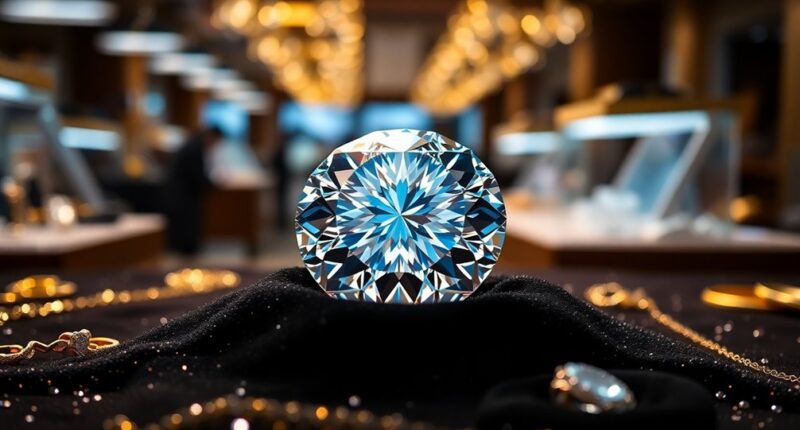You might've noticed the growing trend of lab-grown diamonds, but now a significant deal is poised to reshape the entire $100 billion diamond industry. As major retailers pivot towards synthetic options, they're responding to a shift in consumer values that prioritizes ethical sourcing and sustainability. This transformation isn't just about affordability; it's a complex interplay of regulations, partnerships, and emerging trends that could redefine how diamonds are perceived. What does this mean for traditional diamond mining and the future of luxury? The implications are worth exploring further.
Key Takeaways
- The rise of lab-grown diamonds, now 15% of jewelry sales, offers affordable and ethical alternatives, reshaping consumer preferences in the $100B market.
- G7 sanctions on Russian diamonds and new traceability programs enhance transparency, potentially shifting market dynamics and consumer trust.
- Collaborations, like De Beers and Signet Jewelers, aim to engage younger consumers, blending marketing strategies with education on natural diamonds.
- Increased demand for unique, colorful, and vintage pieces reflects evolving consumer tastes, driving innovation and competition among jewelers.
- Regulatory changes and enhanced certifications for synthetic diamonds ensure compliance and sustainability, impacting both production and consumer confidence in the industry.
Diamond Industry Disruption Ahead

As the diamond industry faces a wave of disruption, it's clear that lab-grown diamonds (LGDs) are reshaping the market landscape.
You'll notice LGDs now account for nearly 15% of diamond-jewelry sales, increasing from 10% in 2023. Thanks to technological advancements, these diamonds are matching the quality and size of natural stones, making them more appealing. The increased demand for lab-grown diamonds drives fierce competition, resulting in price drops of up to 30% year over year. Major retailers, including Signet Jewelers and Blue Nile, are expanding their synthetic collections, while luxury brands cautiously enter the market.
Millennials and Gen Z are particularly drawn to LGDs for their affordability, sustainability, and ethical considerations, signaling a transformative shift in consumer preferences.
Legal Changes Impacting Diamonds
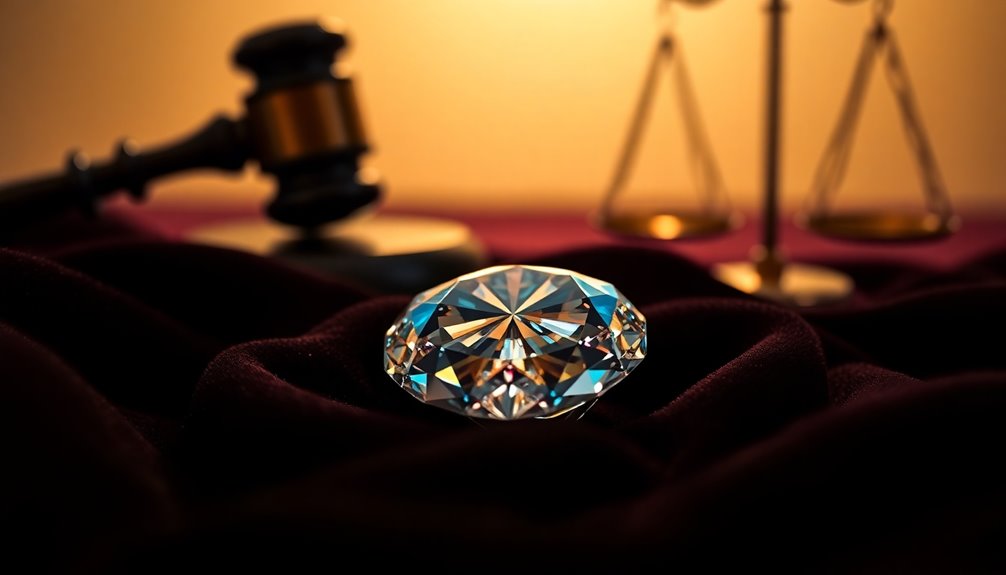
With the rise of lab-grown diamonds reshaping consumer preferences, the diamond industry now faces significant legal changes that could further impact its landscape.
New sanctions on Russia aim to curb funding for its illegal actions, while the G7's traceability program will enforce a certification mechanism for rough diamonds by September 2024. This includes creating a digital twin and utilizing a blockchain ledger for transparency. Additionally, the sanctions will ban direct Russian diamond imports starting January 1, 2024, which could lead to substantial shifts in market dynamics.
The Kimberley Process continues to fight conflict diamonds, requiring certified proof of origin for every consignment.
Meanwhile, countries are enhancing regulations for synthetic diamonds, ensuring clear certifications and environmental compliance.
These legal shifts promise to create a more accountable and sustainable diamond market, emphasizing transparency and ethical sourcing.
Consumer Spending Patterns
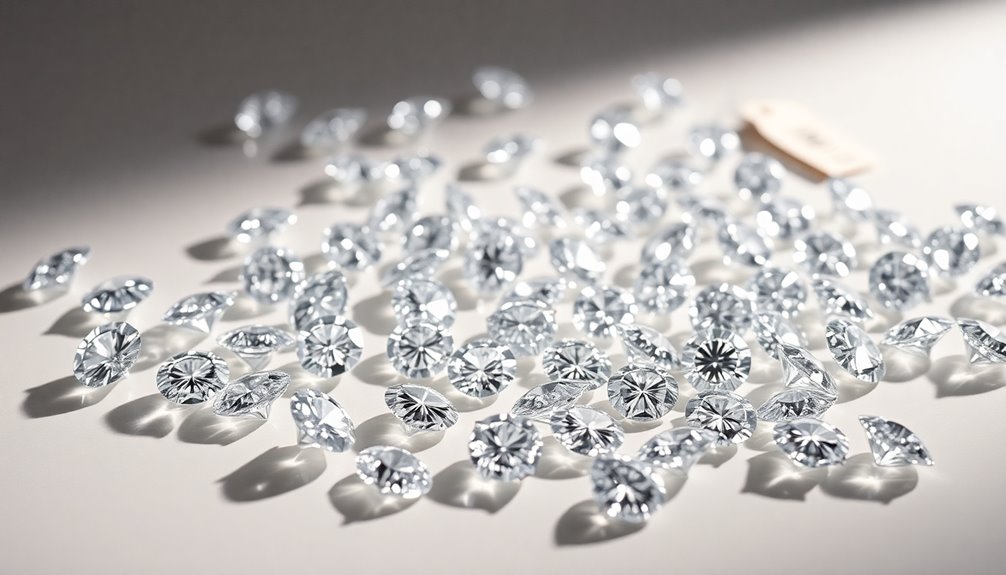
Consumer spending patterns in the diamond industry are rapidly evolving, driven by changing demographics and a growing emphasis on ethical considerations.
You'll notice that younger generations, particularly Gen Z, are increasingly prioritizing ethical purchases and customizing their jewelry choices. This shift aligns with the trend of astrological compatibility influencing personal style choices among consumers.
With the rise of e-commerce, you might find that nearly half of Gen Z's diamond buys occur online, often at lower prices than in stores.
Additionally, colorful and vintage pieces are gaining popularity as consumers seek unique items that reflect personal style. The growing consumer interest in affordable and ethically sourced options is significantly influencing these trends.
As disposable incomes rise, you're more likely to invest in branded jewelry that aligns with your values, making the diamond market more dynamic and responsive to your preferences than ever before.
Corporate Partnerships and Collaborations

While the diamond industry faces shifting consumer preferences, corporate partnerships and collaborations are emerging as powerful tools for growth and innovation.
For instance, De Beers and the Gem & Jewellery Export Promotion Council (GJEPC) are teaming up to promote natural diamonds in India, enhancing market reach through the Indian Natural Diamond Retailer Alliance. This initiative aims to boost the current penetration of natural diamonds in the retail sector, which is only 10%.
Similarly, Signet Jewelers collaborates with De Beers to engage Zillennials in the US, utilizing Signet's digital capabilities.
Artistic partnerships, like Emmanuel Tarpin with de Grisogono, create unique diamond pieces that merge creativity with craftsmanship.
Additionally, initiatives like Signet's training programs educate sales associates on the value of natural diamonds, ensuring informed customer interactions and fostering a stronger connection to these timeless gems.
Government Regulations on Diamonds
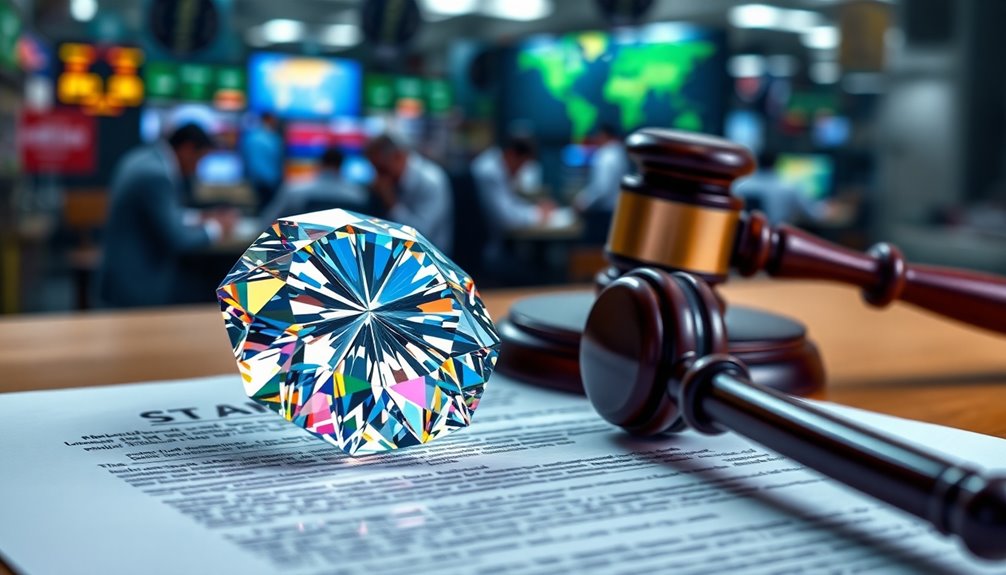
As the diamond industry navigates complex market dynamics, government regulations play a crucial role in ensuring ethical practices and consumer confidence.
The Kimberley Process Certification Scheme (KPCS) mandates that all diamonds traded in the U.S. carry a certification to prevent conflict diamonds. This was reinforced by the Clean Diamond Trade Act (CDTA), which prohibits the import or export of unregulated rough diamonds and outlines penalties for violations.
Regulatory agencies like U.S. Customs and Border Protection ensure compliance, while the U.S. Census Bureau tracks diamond trade statistics. The CDTA has been criticized for not addressing cut and polished diamonds, which limits its overall effectiveness.
Despite these efforts, challenges remain, as critics argue that the KPCS hasn't fully eradicated illegal trade. Continuous improvement and oversight are essential to strengthen these regulations and uphold industry integrity.
Emerging Lab-Grown Diamond Trends
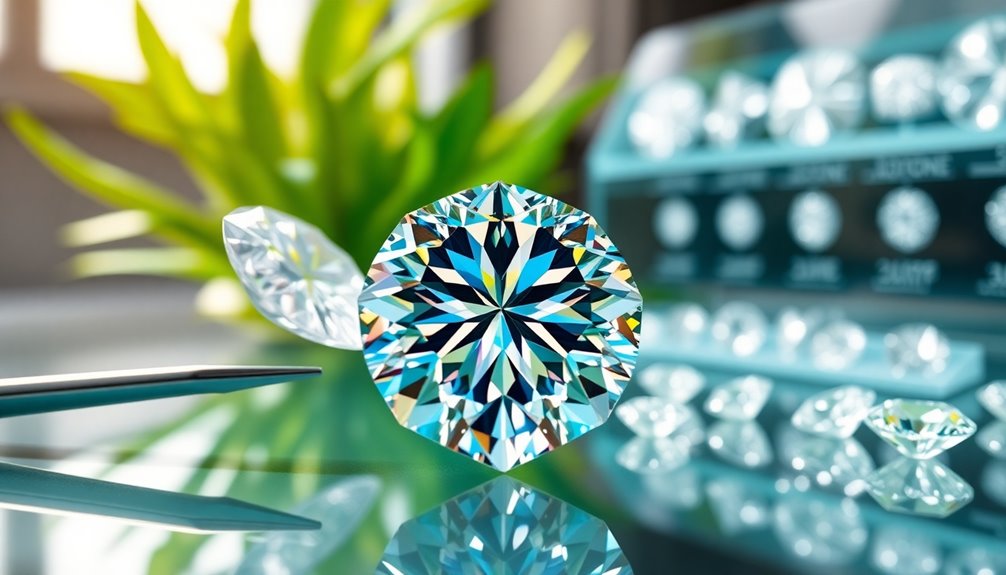
With the diamond industry evolving rapidly, lab-grown diamonds are carving out a significant niche in the market. By 2024, the market value is projected to reach $25.68 billion, growing to $28.27 billion in 2025, reflecting a robust 10.1% growth rate. The lab-grown diamond market is expected to reach approximately $38.86 billion by 2029, showcasing its increasing significance in the global jewelry landscape.
The CVD method dominates production due to its cost-effectiveness and efficiency, with China leading output at 3 million carats. As disposable incomes rise, especially in developing countries, you'll notice a shift in consumer preferences towards ethical and affordable luxury.
Lab-grown diamonds can be priced up to 90% less than natural ones, driving their popularity. Innovations like colored diamonds and new manufacturing facilities signal an exciting future for this thriving sector.
Frequently Asked Questions
How Do Lab-Grown Diamonds Compare to Natural Diamonds in Quality?
When you compare lab-grown diamonds to natural diamonds in quality, you'll find they're nearly identical.
Both have the same chemical structure and durability, making them equally hard and beautiful.
You'll notice that lab-grown diamonds can often be more affordable, typically 30-50% less than their natural counterparts.
While their resale value might be lower, their visual and physical properties remain consistent, ensuring you get a stunning gem regardless of the origin.
What Are the Environmental Impacts of Lab-Grown Versus Mined Diamonds?
When you compare lab-grown diamonds to mined diamonds, the environmental impacts are stark.
Lab-grown diamonds use significantly less energy and water, producing minimal carbon emissions and waste. They don't disturb land habitats, preserving local ecosystems.
In contrast, mined diamonds require immense energy and water, contributing to pollution and land degradation.
How Can Consumers Verify the Authenticity of Lab-Grown Diamonds?
To verify the authenticity of lab-grown diamonds, you should look for certification from reputable laboratories like IGI, GIA, or SGL.
These certificates detail the diamond's characteristics and confirm its origin. Additionally, check for laser inscriptions on the girdle, which provide a unique identifier.
Advanced technologies, like the Yehuda Diamond Detector and X-ray luminescence, can also help confirm authenticity.
Finally, use a loupe or microscope to inspect for inclusions and growth patterns.
What Are the Latest Innovations in Diamond Manufacturing Technology?
Imagine crafting a masterpiece from a rough canvas.
That's what today's diamond manufacturers are doing with innovations like advanced laser cutting and AI. With ultra-fine lasers, they achieve precision cuts that enhance symmetry, while AI optimizes cutting strategies for maximum yield.
Lab-grown diamonds benefit from this technology, ensuring consistent quality and reducing waste.
You're witnessing a revolution, where diamonds become not just beautiful, but also sustainable and affordable.
How Do Cultural Perceptions of Diamonds Influence Market Trends?
Cultural perceptions of diamonds significantly shape market trends. In regions like India and China, diamonds symbolize wealth and modernity, driving demand.
You'll notice that fluorescence is valued differently; while some Western markets see it as a flaw, many Indian and Chinese buyers appreciate its unique allure.
Conclusion
Ironically, as the diamond industry embraces lab-grown gems, it's not just the stones that are changing; it's the very essence of luxury itself. You're now faced with the choice of sparkling ethics and affordability instead of the traditional, costly allure. Who would've thought that your next diamond could come with a backstory of sustainability rather than conflict? As the market evolves, you're not just buying a gem; you're investing in a future where beauty and conscience go hand in hand.
